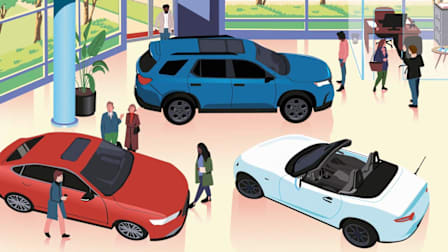How to Get the Best Car-Loan Rate Despite a Low Credit Score
The best rates go to those with good credit, but there are still ways to save money if your credit has room for improvement

If you’ve ever financed the purchase of anything—whether it was a car or a refrigerator—you know your credit score is key to getting a favorable interest rate. The best car deals are reserved for those with the best credit, but that doesn’t mean you have to accept the worst terms if your credit isn’t so good.
Lower Credit Scores Mean Higher Payments
A good credit score usually means you can get a lower interest rate on a loan, while a poor credit score—or having no credit because you’ve never financed anything—can push you into the subprime category. To lenders, a low credit score means you’re a higher risk—or, according to their statistical calculations, you’re less likely to pay back the loan. So you end up having to pay a higher interest rate, which adds significant finance costs on top of the purchase price of the car (or anything else) you’re buying.
Over the past few years, one-fifth to one-quarter of all car loans have been taken out by buyers with subprime credit ratings, according to multiple analysts. That accounts for millions of car loans per year. And many people aren’t keeping up with their bills, says Eric Lyman, vice president of auto finance at Black Book, a CR partner that provides car-pricing data. “While delinquency rates on prime loans are still trending well below historical averages, the subprime delinquency rate is trending near 25-year highs,” he says.
Check With Your Bank Before the Dealer
Perhaps the best way to get a lower rate is to see what your bank or credit union is offering before you approach a car dealer for a loan.
“Before you go to the dealership, shop around and compare interest rates for yourself, so you know what’s available based on your credit and income,” says Chuck Bell, programs director for CR’s advocacy division.
“Many lenders will give you a direct loan, so you don’t have to work through the dealership to get their often higher-priced financing,” Bell says. “You can apply for loans at banks or credit unions, and some lenders will prequalify you for the amount you are seeking with a soft credit check, which won’t hurt your credit score.”
In general, those with excellent credit will get the best rates. People with poor credit ratings or no credit—those who haven’t had to make payments on credit cards and other monthly bills lately—will pay the highest rates. Rates are marked up on subprime loans because the borrower is more likely to default on the loan.
“Your score is designed to be a predictor of your risk of paying back what you borrow,” says Nana-Sinkam. “It looks at your history of paying bills, credit cards, auto, home, and personal loans on time, and uses that information to predict your future behavior and therefore your risk.”
A low credit score means you typically won’t qualify for the catchy zero percent offers highlighted in ads for new cars, and it means you could pay hundreds or even thousands of dollars more in interest over the life of the loan.
Credit Score Categories
According to Experian, one of the major credit reporting agencies, credit scores are broken down as follows:
Exceptional, 800-850: This category covers 21 percent of borrowers, and they get the best rates.
Very Good, 740-799: A quarter of borrowers fall into this category, and they get better-than-average interest rates from lenders.
Good, 670-739: This segment covers 21 percent of borrowers. Experian says only 8 percent of the group is likely to become seriously delinquent on payments.
Fair, 580-669: This category is considered subprime and comprises 17 percent of borrowers.
Poor, 300-579: Only 16 percent of borrowers are in the deep subprime category, which carries the likelihood of extra fees, deposits, or loan application rejections.
How to Save Money on a Car Loan
In conversations with lending industry experts, CR found several ways to save money, even if you have a suboptimal credit score.
Know your credit score. Experian recommends checking your credit score at least once per year as a matter of course. That way, you’ll know where you stand so that you can manage expectations regarding loan eligibility and be aware of what you have to do to bring up your score. You should also look for errors in your credit report, which can affect your score, Bell says.
“Luckily, there is no shortage of sites you can visit online to get a free credit score,” Nana-Sinkam says. In fact, the credit bureaus Equifax, Experian, and TransUnion have announced permanent, free weekly access to credit reports via annualcreditreport.com.
If there’s time, improve your score. That can be done in a number of ways, mostly by paying bills on time. Always pay credit card and other bills when they’re due, even if it’s only the minimum payment. This is good advice for any loan: The more you pay up front, the less you’ll pay in the long run.
Bring a bigger down payment. “This strategy reduces the amount of interest you will pay, since the amount you finance will be smaller,” Nana-Sinkam says. Keep in mind that a down payment can take the form of cash, a trade-in, or a combination of the two.
Get prequalified. Much like knowing your credit score, getting prequalified for a loan from your bank helps manage expectations about what’s possible. Talk to your financial institution to see what’s available.
Nana-Sinkam says that before you get prequalified, it’s a good idea to review your credit report to see whether there are any disputable items. Every little bit helps, and just a few corrections can get you a better rate. Getting approved for a loan before you go to buy a car gives you yet another bargaining chip.
“When you get prequalified, you have a solid starting point for financing negotiations,” Bell says. “Maybe the dealer can get you a better interest rate, and maybe they can’t, but at least you’ll know where you stand.”
See what the dealer or manufacturer is offering. If you’re in the market for a new vehicle, it may have loan programs for subprime borrowers that are unavailable elsewhere. You have to dig around on its website to see what’s out there, and keep in mind that this type of deal is typically going to be found on less-expensive entry-level models.
Consider buying a used vehicle. Used cars generally cost less money to buy than new ones, particularly older models. Also, the value of a used car is more likely to stay stable for longer than a new car, which will depreciate rapidly. That means used-car transactions may pose less risk for the lender, meaning there’s a higher likelihood that a subprime borrower will be approved for a loan.
If you go this route, Bell advises keeping an eye on the overall price of the car you intend to buy. Loan interest rates tend to be higher for used cars and can eat into potential savings if you’re not careful.
Discrimination Raises Loan Costs
Discrimination in auto lending is nothing new. For instance, Ally Financial, which services loans for several automakers, settled a discrimination lawsuit for $80 million only a few years ago.
An academic report published in 2023 found that Black and Hispanic borrowers were 1.5 percent less likely to be approved for a loan and that they paid interest rates that were as much as 0.7 percent higher than those for other borrowers, regardless of their credit. "The study found that although bank loans—which are federally regulated—were much less likely to be discriminatory, more than 80,000 Black and Hispanic borrowers were denied loans they would have been approved for had they been white.
Loans offered by dealers are known as indirect loans because the dealer arranges financing through a third-party company. But dealers don’t have to share loan offers with the borrower. This is how they mark up loans for profit, and as outlined in last year’s study, how dealers were able to charge some borrowers more. A federal rule enacted in 2013 placed auto lending under the guidance of the Consumer Financial Protection Bureau (CFPB) and reduced discriminatory auto lending by 60 percent. But the rule was overturned by Congress several months before the 2018 midterm election.
“Unlike mortgage lenders, who report each application through the Home Mortgage Disclosure Act, auto lenders do not systematically report application or loan-level data, making it difficult for regulators to monitor lenders for discriminatory practices,” says Erik Mayer, an author of the study. “We find the strongest evidence of discrimination in the Deep South, the Ohio River Valley, and parts of the Southwest. Our estimates of discrimination in auto lending correlate strongly with state-level measures of the prevalence of racial biases.”
If you suspect discriminatory lending, Mayer suggests filing a complaint with the CFPB or the Federal Trade Commission.
CR's Build & Buy Car Buying Service
In addition to research and reviews, Consumer Reports offers members access to the Build & Buy Car Buying Service at no additional cost. Through this service, they can compare in-stock vehicles, see what others paid for the car they want, and customize their payments online. Once they find a vehicle they’re interested in, members can get up-front price offers online from local certified dealers. On top of national incentives, Consumer Reports members are eligible for additional incentive offers from select manufacturers through the Build & Buy Car Buying Service. Plus, members can get an instant trade-in value for their current vehicle to use toward their next car purchase.




















